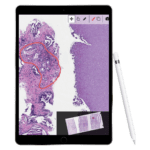Digital pathology is often publicized as being more efficient than traditional pathology, yet can that assertion survive scrutiny? It turns out that, as with many things, the answer is: maybe. A lab’s or pathologist’s efficiency gain or loss with a transition to digital pathology will depend on the new workflow and the type and extent of implementation. Here is a list of factors that would result in no gain or even reduced efficiency and factors that would likely result in efficiency gains.
Factors that would likely result in no gain or even reduced efficiency:
-
Reluctant Labs or Pathologists:
Since pathologists are primarily concerned with not making mistakes and not wasting time, many are reluctant to change a system that, even when suboptimal, is familiar and time-tested. Others may simply relish the hands-on tactile experience of reading glass slides under the microscope. As such, many will only change if clinicians or their chairman/employer require it. When accompanied by a negative attitude, any project’s ability to realize its full potential is limited and may even be sabotaged.
-
Applicability:
Some pathology subspecialties, such as neuropathology or forensic pathology, are so unique that many digital pathology tools have not yet become available nor sufficiently useful to warrant a conversion. If you are considering digital pathology, ensure the solutions can actually improve your workflow and/or patient care.
-
Selecting Incompatible or Insufficient Tools:
When selecting digital pathology tools, make sure the capacity, capabilities, and scalability of those tools meet the needs of the lab and/or pathology group. Otherwise, they may experience unneeded frustrations that could delay, halt, or overcomplicate digital pathology.
Factors that would likely result in efficiency gains:
-
Laboratory Workflow Improvement.
With digital pathology, specimens, blocks, and slides no longer need to be kept together throughout the lab processes since all images get sorted electronically, allowing for efficient first-in, first-out LEAN workflow, especially if a non-sequential filing system is adopted.
-
Efficiency in Case Handling:
The high-resolution digital images created by scanning glass slides can be easily stored, archived, and shared electronically, making them more efficient for primary distribution, storage, and retrieval.
-
Remote Access:
Digital pathology eliminates the need to be physically present in the laboratory, reducing the need for travel and allowing access to pathologists literally anywhere. Digital images are also available as soon as they are scanned, minimizing or eliminating the expense and time spent shipping slides and follow-up special studies.
-
More Efficient Collaboration:
Digital pathology enables easier and quicker collaboration with colleagues and experts in various locations.
-
Pathologist Workflow Optimization:
Digital pathology systems often come with tools for image analysis and annotation. These tools can increase diagnostic efficiency by automating tasks such as cell counting, identifying key histologic findings, and other tedious and repetitive tasks. For example, when annotating prostatic carcinoma on Lumea’s viewer, a digital report is auto-populated with the lengths and areas measured and graphically displayed. The report is immediately ready for sign-out as soon as the pathologist finishes reviewing the specimen without the delay, time, and expense of transcription.
-
AI Software:
Increasingly, various companies are offering algorithms designed for diagnosis, grading, quality control checks, and quantifying various histologic features. In addition to potentially improving care, many of these are time-saving tools for tedious work.
-
Teaching and Training:
Digital pathology can facilitate educational activities, allowing for easy sharing of educational materials and virtual training sessions without having to take, label, and organize photomicrographs, potentially saving time and resources.
 It’s important to note that the efficiency of digital pathology will also depend on the quality of equipment and software and the level of comfort of the pathologists using it. Some pathologists will always prefer the familiarity of traditional methods. However, more and more are discovering that digital pathology is more efficient, especially for those in settings where remote access and computer-aided diagnostic tools are important.
It’s important to note that the efficiency of digital pathology will also depend on the quality of equipment and software and the level of comfort of the pathologists using it. Some pathologists will always prefer the familiarity of traditional methods. However, more and more are discovering that digital pathology is more efficient, especially for those in settings where remote access and computer-aided diagnostic tools are important.
Ultimately, the choice between traditional and digital pathology depends on the specific needs and goals of the laboratory or healthcare system as well as the preferences of the pathologists involved. Many institutions are transitioning to digital pathology to take advantage of its efficiency and the opportunities it offers for improved collaboration and diagnostic accuracy.
Do you still have doubts or want to learn more about the effectiveness and efficiency of digital pathology? Read Dr. Todd Randolph’s experience using Lumea’s technology and how it’s improved his workflow. Ready to take the leap? Try our IMS viewer free today. Unsure where to begin? Check out our digital pathology consulting services.

